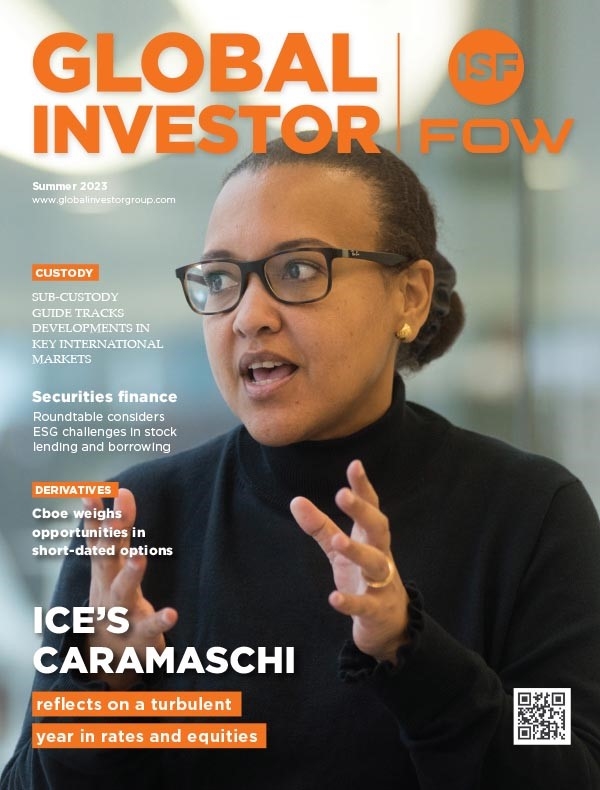BNY Mellon: Collateral meets T2S
TARGET2-Securities, or T2S, is a market infrastructure platform that is fundamentally changing the post trade landscape in Europe.
As part of the roll out of T2S, and in five waves between 2015 and 2017, twenty-three Central Securities Depositories (CSDs) from twenty-one countries will outsource their settlement activities to the common T2S platform which is operated by the Eurosystem (the European Central Bank and the central banks from euro area countries).
Once the migrations have been completed, the participating CSDs will all use the same settlement infrastructure as opposed to using their own legacy settlement platforms.
What this means is that settlement in the participating European markets will become more harmonised and more efficient by using the same infrastructure. Many of the complexities that exist today, especially in relation to cross-border settlement, will be simplified.
Casteleyn: Mark, could you share your thoughts on T2S and the impact it will have on collateral pools and liquidity management?
Higgins: Collateral is expected to be under increasing pressure in terms of demand and supply in the future, so the need for it to be ‘the right collateral, in the right place, at the right time’ remains key in achieving business efficiency.
What this means in practical terms is that collateral is in greater demand as new regulations and commercial developments require the financial industry to be secured or backed by assets around transactions, much of which is covered by ‘HQLA’ or High Quality Liquid Assets by definition.
That means there is an increased focus on assets such as cash, G10 Government Debt, main index equity and highly rated corporate paper. These are all valid forms of collateral seen and applied in areas such as over the counter (OTC) and cleared derivatives, repo and securities lending to name just a few.
So, the right collateral may be defined by regulatory guidance or market demands, but it still leaves the individual players to largely deal with getting it to the right place at the right time. I think T2S can add value in this regard.
Often the term ‘velocity’ is used in association with collateral, in relation to the circulation and use of market assets. For me though, this also implies the speed of delivery and settlement. Under the ‘new world’ of collateral management, speed and settlement finality has become increasingly important.
Having oversight of the collateral pool, understanding what is available and best suited to covering any given need is the first step. Then clients can take action and define what has to go where and when. Executing that action requires an understanding of what is possible in the market against what can be achieved alongside the counterparties own abilities.
Cash remains king in many regards as collateral, especially in the OTC and cleared derivatives markets, given its historic abundance and ease of settlement. However in certain cases cash has become an expensive collateral type due to capital calculations or simply the effect of negative interest rates in Europe.
The use of non-cash assets has been on the rise for use as initial margin when placed with a CCP, and it’s certainly become more common in EMEA as collateral taken against securities lending transactions.
When I used to work as a collateral manager in the 1990s and 2000s we usually moved collateral on a T+2 basis, factoring the two-day settlement lag into our calculations.
Now, with the adas short as possible, with same day being the target. T2S as a platform offers the opportunity for same-day bond settlement with reduced risk of settlement failure, and if this can be made to work in the market, then we have really made a difference.
Casteleyn: Given that most of the T2S volume will be migrated to the platform during waves three and four when we see the ESES markets and Germany join, could we expect to see any additional changes as cross-border settlement becomes more prevalent on T2S?
Higgins: When it comes to government debt as collateral, the market tends to be driven by the main top credits such as the US, UK, Germany and France. These tend to be the preferred collateral types, certainly in the ISDA world of OTC derivative related collateral management. Italy, Spain and other Euro markets also get called into use but often to a lesser extent, so anything related to these markets has the most impact.
Casteleyn: The benefits of T2S are more obvious to a sell-side market participant, such as a broker-dealer client, but what about the benefits for the traditional buyside clients, can we expect to see EMIR and other upcoming regulatory changes have any impact for the buy-side and how clients would look to make use of collateral?
Higgins: You mention EMIR, but it is just one of a range of new regulations in EMEA that have an impact on both selland buy-side participants. I really don’t think of regulation as just having impact on a single segment of the market as they all seem to have both direct and indirect consequences.
For example, is it fair to say that Basel III just impacts banks, or Solvency II matters only to insurance companies? I don’t think so as in both cases these regulations have a major behavioural impact on those directly governed by them whilst clients and counterparts feel the change in terms of business.
In the case of collateral management, Basel III has significant implications for many given that it has changed the way the larger banks have to run their books and operational processing. The buyside clients have to react to that and mirror what becomes a new operating norm. We’ve seen this in the way that some larger buy-side firms have started to look into self-sufficiency around collateral and liquidity management.
By that, I mean setting up a process to support them when the larger dealers can’t manage the supply anymore and an alternative peer-to-peer market needs to step in. That would require the buy-side firm to tap into much of the very same infrastructure that is open to the sell-side, effectively running as one themselves.
Casteleyn: What would you suggest should be the considerations for clients active in the European markets? What should clients be looking to do to prepare themselves for T2S and the impact T2S will have on the collateral market as well as the regulatory challenges that they are facing?
Higgins: That’s a tough one to get right given there seems to be such a long list of things to do. I guess this comes down to education and understanding of the issues at hand and also the tools available to help solve them.
Then it becomes a case of placing these in line for impact assessment and implementation over time. We’ve seen in the past few years what many have coined a ‘regulatory Tsunami’ with one wave hitting and often overlapping against another.
Getting these all lined up and then recognising how T2S can fit in as part of the ‘tool kit’ is part of the process, and given that T2S is a gradual roll out across Europe, it does perhaps allow the user to factor it in and change over time. In this case, not being another ‘Big Bang’ release and change is perhaps to its advantage.
Casteleyn: What does T2S mean for collateral management?
Higgins: T2S is a very important development for the collateral market as by having CSDs in multiple markets using the same infrastructure, clients can have access to a much larger collateral pool via a single entry point and will be able to move collateral between accounts in a much more efficient manner meaning much greater opportunities for collateral optimisation.
From a BNY Mellon perspective, we are taking the opportunity offered by T2S to move assets held within our global collateral management programme to new accounts which BNY Mellon will hold directly with the CSDs, which will bring further efficiencies as collateral assets will then be on the same in-house network as BNY Mellon’s global custody assets.
Working with the Field Effect, we recently released two papers on collateral management market issues, the opportunities currently facing financial market participants and the upcoming regulations, and examined some potential collateral consequences. Future BNY Mellon papers will explore the range of solutions and innovative approaches available to market participants as they tackle new collateral challenges.
The views expressed within this article are those of the authors only and not those of BNY Mellon or any of its subsidiaries or affiliates
Found this useful?
Take a complimentary trial of the FOW Marketing Intelligence Platform – the comprehensive source of news and analysis across the buy- and sell- side.
Gain access to:
- A single source of in-depth news, insight and analysis across Asset Management, Securities Finance, Custody, Fund Services and Derivatives
- Our interactive database, optimized to enable you to summarise data and build graphs outlining market activity
- Exclusive whitepapers, supplements and industry analysis curated and published by Futures & Options World
- Breaking news, daily and weekly alerts on the markets most relevant to you



